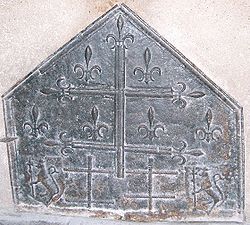
Fireplace fireback
Encyclopedia
A fireback is a piece of heavy, cast iron
, sized in proportion to the fireplace and the fire, that is placed against the back wall of the fireplace.
While wood fires have low efficiency, for those that prefer the atmosphere of a open wood fire, the fireback helps to minimise this problem .
Another important function of the fireback is the protection of the back of the fireplace against heat and flames.
Old firebacks are often beautiful pieces of decorative art and have sometimes been displayed away from the fire.

The increasing use of coal as a domestic heating fuel caused a decline in the need for firebacks and their gradual replacement by integral grates.
Cast iron
Cast iron is derived from pig iron, and while it usually refers to gray iron, it also identifies a large group of ferrous alloys which solidify with a eutectic. The color of a fractured surface can be used to identify an alloy. White cast iron is named after its white surface when fractured, due...
, sized in proportion to the fireplace and the fire, that is placed against the back wall of the fireplace.
Functions of the fireback
The metal is heated by the fire, and then that heat is radiated into the room. The thick iron keeps the heat that would otherwise be lost and gives back this heat to the room. A fireback thus may increase the efficiency of the fire by as much as 50%. The thicker the fireback, the longer and softer this radiative effect.While wood fires have low efficiency, for those that prefer the atmosphere of a open wood fire, the fireback helps to minimise this problem .
Another important function of the fireback is the protection of the back of the fireplace against heat and flames.
Old firebacks are often beautiful pieces of decorative art and have sometimes been displayed away from the fire.

History of firebacks
The oldest firebacks date from the fifteenth century, the early days of casting iron. Early firebacks were decorated with simple designs derived from everyday objects, such as rope, moulds used in the making of certain types of foods (such as butter, biscuits or wafers), and furniture fragments. Designs formed from specially carved wooden patterns or models gradually became more popular and many show the arms of royalty, the church and aristocracy. Religious themes were common particularly in Germany. Later firebacks bore mythological and allegorical subjects, as well as scenes from nature.The increasing use of coal as a domestic heating fuel caused a decline in the need for firebacks and their gradual replacement by integral grates.
Literature
- Carpentier, H.: Plaques de cheminées, 1912
- Nygärd-Nilssen, A.: Norsk Jernskulptur, Oslo, 1944
- Aitchison, L.: History of metals, McDonald & Evans, London, 1960
- Mercer, H.: The Bible in Iron, Bucks County Historical Society, Doylestown, 1961
- Kelly, A.: The book of English fireplaces, Country Life Books, Feltham, 1968
- Kippenberger, A.: Die Kunst der Ofenplatten, Verlag Stahleisen, Düsseldorf, 1973
- Theisen, S.: Der Eifeler Eisenkunstguss im 15. und 16. Jahrhundert, Rheinland Verlag, Köln, 1973
- Pesch, D.: Herdgussplatten, Rheinland Verlag, Köln, 1982
- von den Driech, K.: Handbuch der Ofen-, Kamin- und Takenplatten im Rheinland, Rheinland Verlag, Köln, 1990
- Hodgkinson, J.: British Cast-Iron Firebacks of the sixteenth to mid eighteenth Centuries, HodgersBooks, Crawley, 2010

